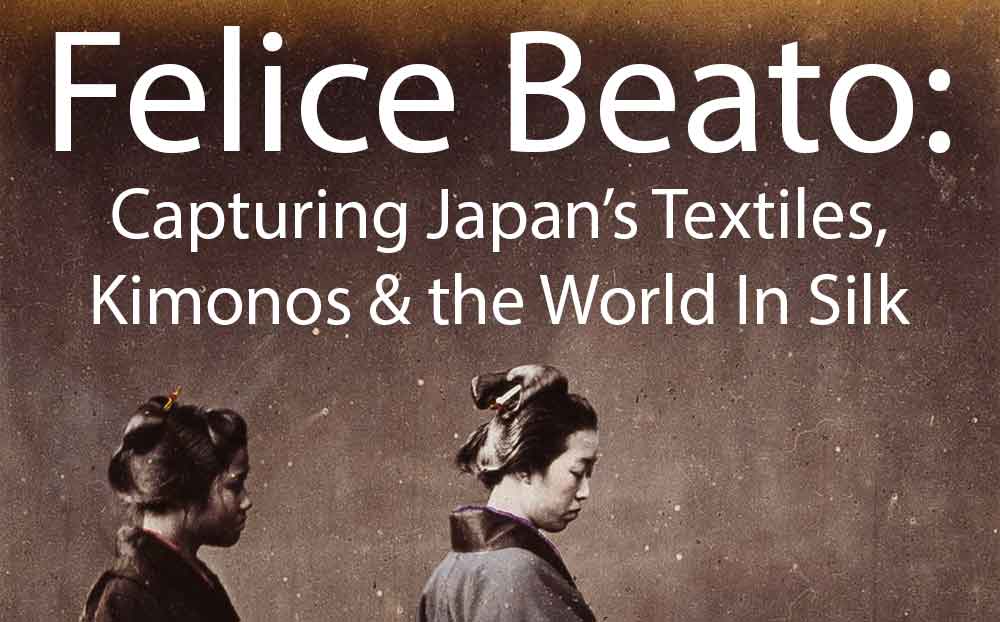
Felice Beato: Capturing Japan’s Textiles, Kimonos & the World in Silk
Share
In the mid‑19th century, as Japan was emerging from over two centuries of isolation, a photographer named Felice Beato arrived. Having already made a name as one of the earliest war photographers in the world, he began capturing images that would fundamentally shape Western ideas of the land of the kimono. Beato’s portraits, genre scenes, and hand‑coloured studio works offer us one of the earliest visual windows into Japanese fabric, costume, texture—and they continue to resonate with lovers of vintage kimono silk today.

‘Putting On The Obi or Girdle’, Felice Beato 1868, (National Gallery of Art, Washington under CC0 licence)
Who was Felice Beato?
Felice Beato (1832‑1909) was an Italian‑British photographer, one of the first Western photographers to take up residence in Japan, arriving in Yokohama in 1863.
He is often called the “father of Yokohama photography" and he remained in Japan for over two decades, working through a period of enormous change as Japan moved from the feudal late Edo era to the imperial Meiji Restoration. (Read out blog post about Japanese Eras here)
He catered to Western tourists / collectors: Beato’s albums often included descriptions written for a Western audience, giving historical/travel commentary, pointing out textile/design interests. He made albums that customers could choose the images for; later, he curated his own selections.
What makes Beato’s work special for lovers of kimonos & vintage Japanese textiles?
Costume & Kimono as Subject:
Many of Beato’s photos are studio portraits or genre scenes in which his sitters are wearing traditional dress—kimono, samurai armour, yukata, ceremonial textiles. In some cases the subjects were posed (hired) to wear particular clothing. These images tend to accentuate fabric folds, patterns, layers like obi, sensu (folding fans), etc. Though a more austere garment than the flamboyant silks of geisha or courtesans, this samurai portrait below reveals structure: the cut, the layering, how silk (or robe fabric) falls and collar style.

Samurai, Yokohama, Felice Beato, 1864-65, Albumen silver print from a glass negative, (Metropolitan Museum of Art, NYC -public domain)
Hand‑colouring techniques mimicking textile colour & pattern:
Beato often hand‑coloured his photographs. This hand‑colouring was influenced by the tradition of ukiyo‑e and Japanese print‑makers who had long worked in colour. The colours were applied by artists (sometimes themselves trained in colouring woodblock prints) using water‑soluble pigments. The result: the patterns of fabric, the sheen of silk, the contrast between layers (e.g. inner lining, collar, obi) are more visible than in many purely black‑and‑white works. This makes his images particularly rich for those studying or appreciating vintage kimono silk.

No Title (Maiko), Felice Beato, 1866-68, Albumen silver photograph, coloured dyes
(National Gallery of Art, Washington under CC0 licence)
Scenes of everyday life, costume changes, and “hidden” or ephemeral textile details:
Beyond formal portraits, Beato’s albums show people “at rest,” “at leisure,” performing daily tasks: ladies adjusting sashes or collars, girls or women in more casual dress, scenes at the toilet or at the bath‑house, etc. These often preserve details now lost—fabric edges, lining colours, stitch work, ornamentation.

Woman At Toilette, Felice Beato, 1868 ,Albumen Print with applied colour, (National Gallery of Art, Washington under CC0 licence)
Textile as identity & change:
Beato was photographing during a period when Japanese dress traditions were under pressure from modernisation, Western influence, new trade, and governmental reform (for example, efforts later in Meiji times to modernise clothing for officialdom, military, etc.). So his images preserve or ‘freeze’ a moment in time of traditional textile culture just before or during its transformation. For vintage kimono enthusiasts, that makes them particularly poignant: the types of silk, weaving, patterns, dyeing, use of motifs that might later fall out of fashion or technique.

Geisha at her Toilet, Felice Beato, 1863-1877 (Rijks Museum, Amsterdam -public domain)
A time of change.
These works are part of a genre reflecting Japan’s rapid modernisation during the late Edo / early Meiji eras. They depict foreign technology (cameras, photographic studios) as exotic novelties, often juxtaposed with traditional Japanese dress or spaces. These Japanese woodblock prints (Yokohama-e) below depict foreigners and scenes of the new photographic studios created by the likes of Beato showing how photography was being integrated into local visual culture.

Sanju‑ichi Shashin (No. 31: Photography), from the series Kaika ninjō kagami (A Mirror of Customs in Flower), by Toyohara Kunichika, published in Tokyo, 2 April 1878. Depicts a woman operating a tripod‑camera. (© The Trustees of the British Museum under CC BY-NC-SA- 4.0)

“A Foreign Camera (Gaikoku shashinkyo no zu)” by Utagawa Yoshikazu, ca. 1860. Also titled Foreigners Employing a Camera. (Image courtesy of Met and Chicago Institute collections)
An almost-lost world?
In 1866, Beato's studio was destroyed in a major fire, which wiped out much of his work in Yokohama. But within a year or two he had rebuilt and re-established his studio and continued to produce albums. These albums are now very rare and considered collectors items, often fetching large sums at auction. Beato also travelled in remote areas, so some of his photographs record textile patterns and dress in places otherwise little documented. He also had apprentices who went on to produce their own amazing images, maybe that is a story for another day...
Do you fancy a little piece of history for yourself? Have a look at our square antique kimono silk cushion covers here or our long bolster pillows made from vintage wedding kimono silks here or sign up to the mailing list in the box at the bottom of this page.
Thanks for reading!
Ellie x
Pin it!

